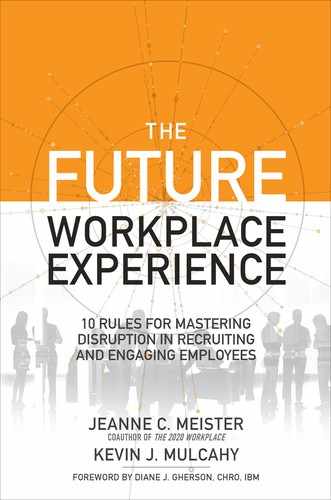Foreword
There was a time when successful onboarding meant that new hires learned what they needed to learn, filled out the forms they needed to complete, and met their manager on their first day. That was the functional lens. Yet turn it around and look at the same scene through the lens of the employee—and ask, is this iconic?
To my dismay, at IBM, the answer was no. We had architected a flawless HR process, but many of our new hires were underwhelmed during their first few days. It became clear that it would take a redesigned cross-functional effort—with security for badges, IT for collaboration software and device connectivity, and real estate for workspace—to get it right. And it took design thinking to create the disruptive ideas needed to reinvent the experience, making it iconic from end to end.
This book turns the world of corporations on its side and looks at it from the standpoint of the experiences we create—for employees and ultimately customers.
Thirty years ago, companies were reengineering themselves around processes, standardizing and outsourcing them for higher levels of efficiency. Reengineering the Corporation: A Manifesto for Business Revolution by Michael Hammer and James Champy became the guidebook for leaders who shaped these organizations of the 1990s.
The Future Workforce Experience serves as an equally indispensable guidebook for the next wave of corporate reinvention—experience design. Meister and Mulcahy describe how companies today are being radically reimagined around the experiences they create—either intentionally or by default. The authors distill the new rules of the road for leaders to transform organizations around the compelling experiences that will engage their people and drive business success in the digital age.
Each chapter takes the reader on a guided tour of the profound changes going on inside corporate America today. We see the impact of the new workforce generation, reared on Facebook, Netflix, Instagram, and Snapchat. Unlike prior generations, millennials wield considerable labor market power, and as they are digital natives, their expectations are driving a sea change inside corporations.
We are shown how organizational boundaries made porous by the Internet are now transparent in the age of social computing, hastening the demise of the hierarchical workplace and democratizing information and power. We learn about the newer enterprises such as Airbnb, Glassdoor, and Rackspace that have provoked established competitors to rethink their business models, organization paradigms, and talent strategies. And we get inside the companies that are pivoting to the future—such as Cisco, IBM, Microsoft, and SunTrust.
One thing that is becoming clear is that organizations built in the industrial era are ripe for disruption. They were built on the concepts of hierarchy, functional expertise, and jobs. But what replaces these iconic artifacts of classic organizations? Meister and Mulcahy describe new types of leaders, new ways of working and staffing, and new forms of corporate infrastructure that are starting to appear in the corporate landscape. They provide a new architectural blueprint to reshape our organizations.
Creating a compelling workplace experience means going well beyond corporate mission statements to forging emotional connections. Agile leadership is a form of servant leadership and not just a methodology for coders. And managing workspace goes well beyond eliminating cubicles and offices to promoting conviviality, wellness, and chance collisions.
Much has already been made of the consumerization of the workplace experience and the impact on the human resources function. Recruitment was the first area to change, borrowing heavily from digital marketing. With big data analytics and mobile and social technologies, HR is becoming less process-bound, simplifying the employee experience and making it much more personalized.
But we would be missing the point if HR professionals stopped at making the workplace experience more consumer-grade. As this book lays out, the experience lens changes the mission and purpose of the HR function and blends its edges with real estate, internal communications, and IT. In my view, HR is an artifact of the industrial age—and if it is not reshaped and reinvented, it will end up on the sidelines of the most important changes affecting people in their organizations in our lifetimes. Ultimately, as suggested in this book, HR can use the power of crowdsourcing, cognitive computing, and social sentiment analysis to build a more transparent and democratic organization where employees are not simply consumers but cocreators of the organization and their careers.
This book is more than a guidebook; it is a call to action. The authors mine a lot of data to make a compelling business case for change, including over 30 studies from Aon Hewitt, Deloitte, PwC, Towers Watson, McKinsey, and professors at Harvard, London Business School, MIT, Oxford, and Wharton, among others. Embrace the future they describe, and create competitive advantage. Ignore it at your peril.
DIANE J. GHERSON
Chief Human Resource Officer
